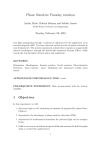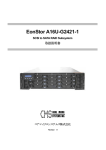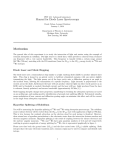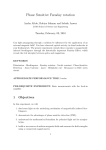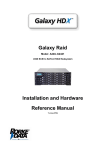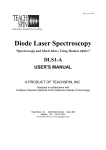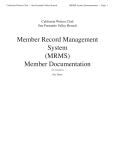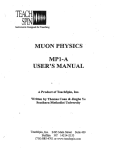Download Magneto-‐Optic Effects
Transcript
EP421 Magneto-‐Optic Effects Advanced Optics Lab Manual © Michael P. Bradley 2013 Magneto-‐Optic Effects Introduction: A normally isotropic dielectric (e.g. glass or isotropic crystal) with a single value of relative permittivity εr can become optically active when a magnetic field is applied. The optic axis of this induced optical activity is aligned with the axis of the applied magnetic field. This effect has many practical applications: magneto-optic material diagnostics, optical polarization modulators for communications applications, and laser beam isolators (“optical diodes”) are just a few examples of these. Physics: As we have seen in class [1], the dielectric tensor for an optically active (uniaxial) crystal is described by a dielectric tensor with imaginary elements in the offdiagonal positions, as follows: " ε ia 0 % $ 1 ' ε = $ −ia ε1 0 ' $$ '' # 0 0 ε3 & Note that the tensor is Hermitian. We take the tensor to be pure numbers (i.e. relative permittivities. In quartz a is quite small, a ≈ 7 x 10-5. This has the effect that the optical rotation of the plane of polarization is only observed for rays travelling quite close to the optic axis. In a magneto-optic material the situation is a bit different; instead of being a fixed value, a is proportional to the applied magnetic field magnitude B0, as follows: a = rB B0 If we use this value of a in the result we derived in class for how the refractive index difference between left-handed (L) and right-handed (R ) polarized light propagates, we obtain the following result: δ n ≡ nL − nR = n 3rB B0 (This results is valid for rB B0 << 1 2 ) n The angle of rotation of the plane of polarization then depends on the distance propagated in the magneto-optic material as follows [1]: 1 1 k0δ n = k0 n 3rB B0 = CV B0 2 2 1 where CV = k0 n 3rB is called the Verdet constant (sometimes the symbol V is used for the 2 Verdet constant but we have already used V for the Abbe number for glass. Not enough letters in the alphabet!) Experimentally, we can measure the Verdet constant for a given material by measuring the rotation of the plane of polarization which it imposes on an initially polarized beam of EP421 Magneto-‐Optic Effects Advanced Optics Lab Manual © Michael P. Bradley 2013 light. From the above derivation the rotation angle ΔΦ which an initially polarized beam of light undergoes as it traverses a length L of material with Verdet constant CV exhibiting the Faraday effect is given by ΔΦ = CV BL where B is the magnetic field. Thus a plot of angle of rotation ΔΦ vs. B should be a straight line with slope CVL. Dividing by this experimentally determined slope by the path length L of the light beam in the sample gives the Verdet constant CV. Note that Verdet constants are normally tabulated in non-SI units of arc-minutes/Gauss.cm. Thus it will be necessary to use these units to compare your measured Verdet constant in this lab with tabulated values for different materials. The Verdet constant CV varies widely for different materials. It is also a function of wavelength, varying approximately as 1/λ2. The Verdet constant is also temperature dependent and can be very large from some specialty rare-earth glasses at cryogenic temperatures. Lab learning outcomes: In this lab experiment you set experiment with the Faraday effect and use it to measure the Verdet constant for a glass rod. You will verify the linearity of the Faraday rotation angle with applied magnetic field strength B, and also measure the wavelength dependence of the Verdet constant CV = CV (λ). Equipment required: Red HeNe laser (λ=632.8 nm) or diode laser (λ=650 nm Thorlabs CPS180) Green DPSS Laser (λ=532 nm-- Thorlabs) Blue GaN Diode Laser (λ=405 nm-- Thorlabs) Faraday Effect System (from Teachspin, Inc.)- N=1354-turn solenoid, analyzer Polaroid, photodiode detector mounted on antique 18th century wooden breadboard Solenoid DC power supply Polarizer Polaroid (optional-only needed for unpolarized laser sources) Analyzer Polaroid Experimental Procedure (a) Set up the Teachspin Faraday Effect system in accordance with the manual (red binder). Then follow steps (b) – (f) for each of the three lasers (Red, Green, and Blue) (b) Check if the laser output is polarized (some are, some are not- you need to check). If the laser is not polarized, use an initial Polarizer polaroid P after the laser to polarize the beam before entering the glass rod (c) Use solenoid current set to 0 use the photodiode detector to measure the he transmitted light intensity I as a function of the angular setting of the analyzer polaroid. You should observe a Malus’ Law dependence I = I0cos (θ) where θ is EP421 Magneto-‐Optic Effects Advanced Optics Lab Manual © Michael P. Bradley 2013 the relative angle between the plane of polarization of the polarized laser beam and the transmission axis of the analyzer A. (You measured this type of dependence in detail in the Polarization Lab. Recall that the Jones Calculus can easily be used to verify Malus’ law for this configuration). This check of Malus’ law dependence is a good test that your input beam is polarized. (d) Now measures the angle of rotation of the plane of polarization of the beam. Do not exceed 3 Amps for the solenoid current. If you wish you may reverse the direction of the solenoid current to increase the range of measured angles of rotation (the sense of rotation of the plane of polarization will be reverse if the current is reversed (e) Plot your measured Faraday effect rotation angles ΔΦ vs. the applied magnetic field B (see Note A on magnetic field calibration below). (f) Compare your measured value of CV for the glass rod with published (handbook) data for similar types of glass. How similar are your results ? If they are different, can you imagine factors which influence this (such as temperature, wavelength etc.) ? Estimate quantitatively the magnitude of these perturbations. (g) Plot CV vs λ. Do your data show the expected 1/λ2 dependence ? NOTE A: Magnetic field calibration. The Teachspin Faraday rotation system which we use comes with a solenoid into which we insert the glass Faraday rod. The Faraday effect is a consequence of the applied magnetic field strength along the axis of the rod. The current in the solenoid is the ultimate source of this magnetic field. To extract an accurate Verdet constant we need to calibrate the magnetic field strength B in terms of the solenoid current I. We have 3 basic ways to do this: Manufacturer calibration: The Teachspin Faraday rotation system user manual provides a calibration for B=B(I). Consult the manual to check this calibration. It is hopefully accurate. Nonetheless it is worthwhile for us to check the value. Measure with Gaussmeter: Use a Gaussmeter or compact Hall probe to measure the magnetic field along the axis of the solenoid. A compact Hall probe may be able to fit inside the solenoid bore but our standard laboratory Gaussmeter probe heads do not. Thus we are only currently able to measure the axial fields at the two ends of the solenoid. The field within a solenoid should be quite uniform near the center, and far away it falls off as 1/r3. At the ends of the solenoid the field should ½ of the value in the centre. In this way the Gaussmeter reading can be used to calibrate the field in the solenoid centre. EP421 Magneto-‐Optic Effects Advanced Optics Lab Manual © Michael P. Bradley 2013 Calculate: The B field in a uniform solenoid is given by B = µ0(NI)/Lsolenoid where µ0 = 4π × 10-7 T.m/A is the permittivity of free space, N is the number of turns, and Lsolenoid is the length of the solenoid. Using the measured length of the solenoid and the number of turns marked on the apparatus, compute the relation between B and I and compare it against the calibration provided by Teachspin and the Gaussmeter measurements. NOTE B: Use of Lock-in amplifier for increased sensitivity. The Verdet constant for ordinary glasses tends to be rather small and the rotation observable with the magnetic fields achievable with our solenoid may not be large. You can increase the measurement precision using a lockin amplifier technique if you wish. (Please consult with the instructor) References [1] Lipson, Lipson, and Lipson. Optical Physics, 4th ed., Cambridge University Press (2011). [2] E. Hecht, Optics, 2nd. ed., Addison-Wesley (1987) [3] Teachspin Inc. Faraday Effect system manual (available in the lab)




